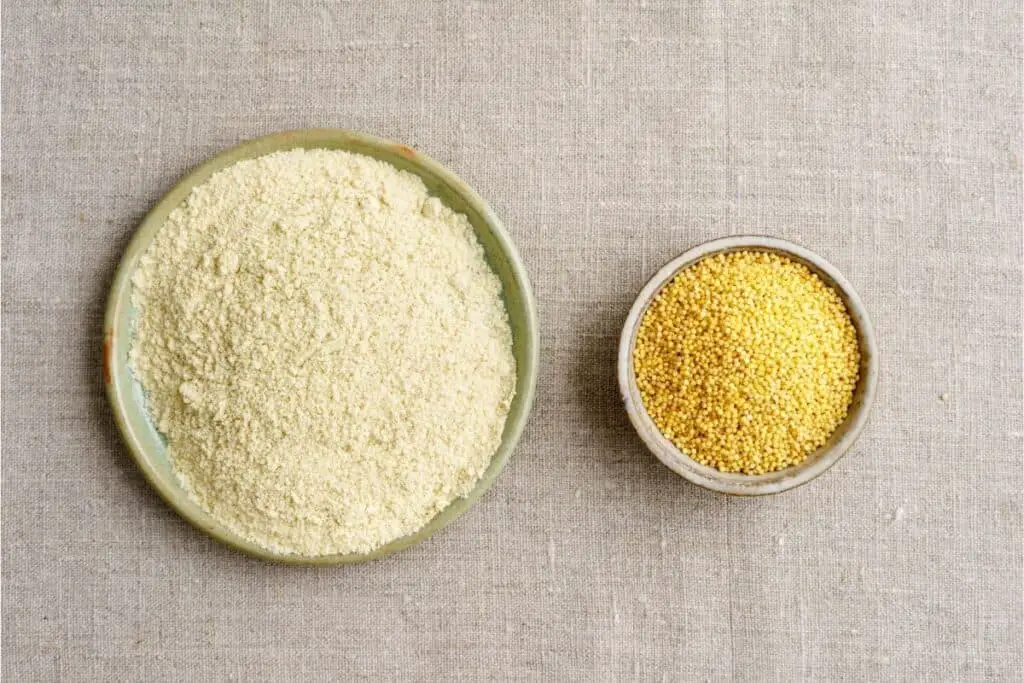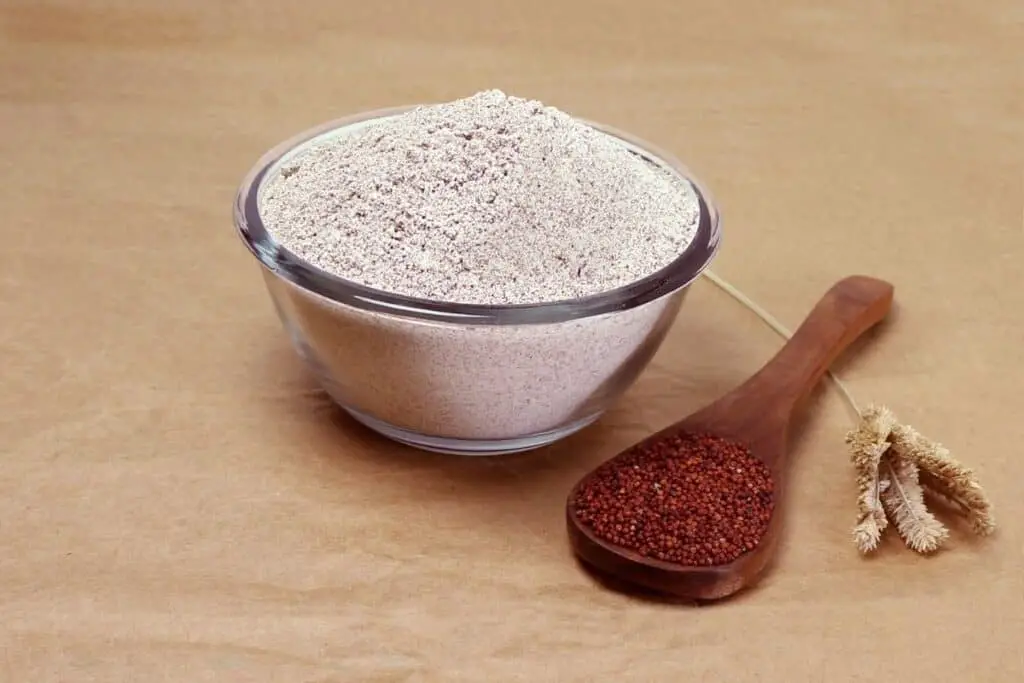To learn about millet flour, we have to start at the source: millet. Millets are tiny seeds from grasses native to Africa. They are often eaten as porridge or added to bread dough.
Millet has been cultivated for thousands of years and is considered a staple food crop in some parts of the world.

It is also used for the production of millet flour, which can be used as a gluten-free alternative to regular flour for baking all kinds of foods.
In this article, we’ll be taking you through everything you need to know about this unusual ingredient and how you can include it more in your own diet.
What Exactly Is Millet?
Millet is a fairly rare ingredient that you don’t often see included in recipes.
Like we said before, it’s a grain that is considered a part of the grass family of plants. It grows most commonly across Africa and Asia, where it is also most commonly consumed.
The grain doesn’t have a huge presence outside these continents but is gaining popularity across North America in recent years due to its health benefits.
Millet looks pretty much as you’d expect: a fine, grainy substance with a pale yellow color. In terms of its flavor, millet tends to have a slightly sweeter taste than most other grains and some even commend it for its nutty qualities.
As you can imagine, this makes it pretty popular for use in all kinds of dishes, like porridge or as a substitute for rice.
What Are The Health Benefits Of Millet?
One of the main reasons why people are starting to incorporate millet into their diets is because of its many nutritional benefits.
Millet contains high levels of protein, fiber, iron, magnesium, phosphorus, zinc, selenium, vitamin B6, folic acid, riboflavin, thiamine, niacin, pantothenic acid, copper, manganese, potassium, calcium, phosphorous, vitamins A and C, and omega 3 fatty acids.
It’s also very low in calories (about 100 per cup) and carbohydrates.
This makes it an excellent source of nutrition for those who want to eat healthier.
This is what one packet of cooked millet looks like in terms of nutritional value:
- 207 calories
- 41 grams of carbohydrates
- 2.2 grams of fiber
- 6 grams of protein
- 1.7 grams of fat
- 25 percent of the daily value of phosphorus
- 19 percent of the daily value for magnesium
- 8 percent of the daily value folate
- 6 percent of the daily value of iron
Millet provides more amino acids than most other cereal grains. These compounds are the basic units used to make proteins.
How Do I Use Millet In My Diet?
If you’ve never tried eating millet before, then now might be a good time to start!
You can easily incorporate millet into your daily meals by adding it to salads, soups, stews, casseroles, sauces, bread, pasta, muffins, pancakes, waffles, pizza crusts, and more.
You can also try sprinkling it on top of breakfast cereals, oatmeal, yogurt, and smoothies.
In addition to being used as a food additive, millet has been shown to help reduce cholesterol, improve digestion, boost energy and promote healthy skin.
Let’s take a look at some different ways you can include millet in your diet…
How To Cook Millet
To start with, you should make sure your millet is prepared for cooking. If it comes straight from the grocery store, it’ll likely be clean already, but there’s no harm in rinsing it a couple of times to remove any leftover small pieces of dirt.
Next, it can be beneficial to soak your millet for 4-8 hours before you even start cooking. It’s not necessary to perform this step at all, but it does give the millet a creamy texture and makes it easier to digest.
Once you have your millet, soaked for 4-8 hours or not at all, you’re ready to start cooking.
Cooking On The Stovetop
In a sufficiently large pot or pan, add your millet and some water, then turn the heat to medium. The ratio of millet to water should be roughly 1:1.5, meaning for every 1 cup of millet you use, you should also add 1.5 cups of water.
Once the water starts boiling, reduce the heat slightly, so it sits at a simmer.
Now, you can leave the millet to cook until it has absorbed all the water in the pot/pan. If you’ve soaked your millet beforehand this will take about 7 minutes but if not, it will take around 12 minutes.
Once the water has all been absorbed, take the pan off of the heat and leave the millet to sit for another 10 minutes or so. The residual heat left within the mass of millet grains will cause it to cook and absorb for a little longer.
Then, fluff it up with a fork and serve!
Cooking With A Rice Cooker
The process for cooking millet with a rice cooker is very similar to the process of doing it on the stovetop, with a few simple extra steps.
Use the same quantities of water and millet but for every cup of millet you use, add a teaspoon of cooking oil to the cooker to prevent it from sticking or clumping.
From here, the process is as simple as setting your cooker to a ‘white rice’ setting or just pressing the ‘cook’ button.
Once it’s finished, leave it for 10 minutes and fluff it up with a fork before serving.
Cooking With An Instant Pot
Using an instant pot to cook your millet can be just as simple as using a rice or pressure cooker.
Add the same quantities of millet, water, and cooking oil as before.
Then, close the lid securely and set your instant pot to a ‘high pressure’ setting.
Leave it to cook for 4 minutes if you have pre-soaked your millet or 8 minutes if it’s not been soaked already.
Once again, leave it for 10 minutes, fluff it with a fork and serve!
What’s The Difference Between Millet And Millet Flour?
Millet flour is simply made with ground-up millet grains. This means that it comes from the same plant as whole millet grains, so there isn’t much difference between them.
However, if you’re looking to bake with millet flour instead of using regular wheat flour, then you may find that it does require slightly different techniques than normal.
For example, when making cookies, cakes, or other baked goods, you will need to use less liquid and add more eggs to compensate for the fact that millet flour is lower in gluten.
When cooking with millet flour, you should also make sure that you cook it longer than usual. You won’t get the same results as with regular flour, but it shouldn’t take too long to cook.
Can You Make Millet Flour At Home?

If you want to make your own flour from millet, then yes, you absolutely can! The process is also a lot simpler than you might think.
All you need to do is grind your millet into a fine powder using a blender or coffee grinder. Start by blitzing your millet for around 30 seconds, stop to scrape down the sides of your blender or grinder, then blend for another 30 seconds.
Don’t worry too much about over blending your millet because you’re trying to create a very fine powder at the end of the process.
After blending it all to an evenly fine consistency, sift your millet flour through a fine-mesh sieve to remove any larger pieces that you can’t quite see.
Once you’ve finished whipping up a batch of millet flour, it’s important to store it properly. Keep it in an airtight container and away from any moist areas like your kitchen sink.
Allowing moisture to get into the container will completely ruin your millet flour and leave it useless.
You can keep the flour for up to 3 months after making it yourself, as long as you store it away properly.
What Can Millet Flour Be Used For?
While millet flour isn’t exactly a staple food ingredient, it does have many uses outside of being used to make bread.
It can be added to baked goods such as muffins, cakes, cookies, pancakes, waffles, scones, biscuits, and more.
It can even be used to thicken sauces, gravies, soups, stews, casseroles, and other dishes.
And, when combined with baking soda, it can act as a leavener for baked goods.
How To Use Millet Flour In Baking
Combining millet flour with baking soda makes for a great alternative to wheat flour in most recipes.
This means you don’t have to go out and buy expensive gluten-free flour mixes which are often full of additives and preservatives.
Instead, you can simply combine your millet flour with baking powder and baking soda to create a homemade mix that’ll work wonders in your baking.
To start off, measure out 1 cup (250 ml) of your millet flour and add it to a bowl.
Next, whisk together 2 teaspoons (10 ml) of baking soda and one teaspoon (5 ml) of salt.
Now, pour this mixture into your dry ingredients and stir well until everything is mixed together.
Now, transfer the batter to a large mixing bowl and use a spatula to fold in your wet ingredients.
Finally, spoon the batter into your prepared pan(s), bake it, and enjoy!
The best part about millet flour is that it doesn’t require any special equipment to prepare.
Just follow our simple recipe above, and you’ll soon be enjoying delicious treats made with this versatile grain.
When Can You Not Use Millet Flour?
Like we said before, you can use millet flour pretty much interchangeably with regular flour, but this isn’t always the case.
One thing millet flour lacks that regular flour has an abundance of is gluten. This is what gives bread and pasta dough a pliable, elastic quality. In fact, the whole point of needing these doughs is to develop more strands of gluten within them.
Because millet doesn’t have any gluten, doughs made with millet flour are not very elastic at all and are often difficult to work with.
Not only this, but the overall product, whether it’s bread or pasta, will have a much denser, less desirable texture.
Particularly when making pizza or pasta dough, millet flour should be avoided and some other specialist, gluten-free flour should be used instead.
Is Millet Good For The Environment?
Millet is a nutritious food that can be grown without much water or pesticides. It’s also pest resistant, so it doesn’t need as many chemicals. A growing number of people want to eat more natural foods, and this is why millet is becoming popular.
Because it grows quickly and produces high yields, these grains are perfect for small farmers who may not have access to land.
It’s also easy to grow and maintain, meaning that there’s less labor involved. This helps reduce costs while still providing quality products.
So, if you’re looking to feed your family healthier meals but aren’t sure where to begin, try millet flour.
It’s a healthy choice that won’t break the bank and will allow you to provide your family with environmentally-friendly meals.
Can Animals Eat Millet?
A common question people ask about millet is whether their pets can eat it safely or if that will cause them some kind of health problems.
In general, millet tends to be harmless to birds, whether it be birds that you keep as pets or wild birds that might visit your backyard.
The same is true of deer, who can also eat millet completely safely. As deer get older, they tend to be less attracted to the prospect of millet as a snack but leaving some out in your yard could work a treat to attract some young deer.
In fact, even dogs can eat millet safely! It provides a great source of carbohydrates for them and is even easier for them to digest than wheat. If you’re trying to include more millet in your family’s diet, you can even include the household pet!
Conclusion
If you’ve been wanting to add more millet to your diet, then here’s how to do it. Just make sure to read through our tips on using millet flour first!
We hope you enjoyed learning about millet flour. Have fun whipping up some fun new recipes with it!
